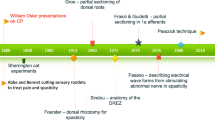Abstract
The increasing interest in selective posterior rhizotomy for reduction of spasticity in children with cerebral palsy and other neurological disorders comes from the selectivity that this procedure has achieved with intra-operative electromyographic monitoring. Thirty patients were operated on between April 1989 and October 1991. Spasticity was of cerebral origin in 27 cases and secondary to spinal cord lesion in 3 others. A reduction in the abnormally high muscle tone was observed in all cases, mainly in the lower extremities, but also, to a lesser degree, in the upper extremities. All patients showed functional improvements that depended on the individual preoperative condition.
Even severely disabled patients with quadriplegia and intellectual impairment, whose spasticity interfered with their daily care, had a significantly improved quality of life after rhizotomy. These patients became much looser, with better swallowing and less drooling, and were much more easily managed by their caretakers. Preliminary results with follow-up from 1 to 30 months indicates that selective posterior rhizotomy is a safe procedure which contributes to significant functional improvement in spastic patients.
Similar content being viewed by others
References
Abbott R, Forem S, Johann M (1989) Selective posterior rhizotomy for the treatment of spasticity: a review. Child's Nerv Syst 5:337–346
Abbott R, Deletes V, Spielholz N, Wisoff JH, Epstein FJ (1990) Selective posterior rhizotomy: pitfalls in monitoring. In: Marlin A (ed) Concepts in pediatric neurosurgery. Karger, Basel, pp 187–195
Arens LJ, Peacock W, Peter J (1989) Selective posterior rhizotomy: a long-term follow-up study. child's Nerv Syst 5:148–152
Barolat G, Davis R (1980) Neurophysiological mechanisms in abnormal reflex activities in cerebral palsy and spinal spasticity. J Neurol Neurosurg Psychiatry 43:333–342
Burke D (1988) Spasticity as an adaptation to pyramidal tract injury. Adv Neurol 47:401–423
Dimitrijevic MR (1985) Spasticity. In: Swash M, Kennard C (eds) Scientific basis of clinical neurology. Churchill Living-stone, New York, pp 108–115
Fasano VA, Broggi G, Barolat-Romana G, Sguazzi A (1978) Surgical treatment of spasticity in cerebral palsy. Child's Brain 4:289–305
Fasano VA, Barolat-Romana G, Zeme S, Sguazzi A (1979) Electrophysiological assessment of spinal circuits in spasticity by direct dorsal root stimulation. Neurosurgery 4:146–151
Fasano VA, Broggi G, Zeme S (1988) Intraoperative electrical stimulation for functional posterior rhizotomy. Scand J Rehabil Med Suppl 17:149–154
Gros C (1979) Spasticity. Clinical classification and surgical treatment. Adv Tech Stand Neurosurg 6:56–92
Lazareff JA, Mata-Acosta AM, Garcia-Mendez MA (1990) Limited selective posterior rhizotomy for the treatment of spasticity secondary to infantile cerebral palsy: a preliminary report. Neurosurgery 27:535–538
Newberg NL, Gooch JL, Walker ML (1991–92) Intraoperative monitoring in selective dorsal rhizotomy. Pediatr Neurosurg 17:124–127
Peacock WJ, Arens LJ (1982) Selective posterior rhizotomy for the relief of spasticity in cerebral palsy. S Afr Med J 62:119–124
Peacock WJ, Staudt LA (1991–92) Selective posterior rhizotomy: evolution of theory and practice. Pediatr Neurosurg 17:128–134
Peacock WJ, Arens LJ, Berman B (1987) Cerebral palsy spasticity: selective posterior rhizotomy. Pediatr Neurosci 62:119–124
Sherrington CS (1898) Decerebrate rigidity and reflex coordination of movements. J Physiol (Lond) 22:319–337
Storrs BB, Nishida T (1988) Use of the “H” reflex recovery curve in selective posterior rhizotomy. Pediatr Neurosci 14:120–123
Storrs BB, Gabler-Spira D, Dias L, Nishida T (1990) Selective posterior rhizotomy. A review of 100 cases. In: Marlin A (ed) Concepts in pediatric neurosurgery Karger, Basel, pp 179–186
Author information
Authors and Affiliations
Rights and permissions
About this article
Cite this article
Schijman, E., Erro, M.G. & Meana, N.V. Selective posterior rhizotomy: experience of 30 cases. Child's Nerv Syst 9, 474–477 (1993). https://doi.org/10.1007/BF00393554
Received:
Issue Date:
DOI: https://doi.org/10.1007/BF00393554




